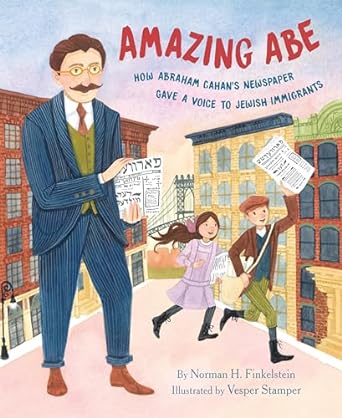Stamper, Vesper
4 Articles
Last 30 days
Last 6 months
Last 12 months
Last 24 months
Specific Dates
From:
To:
Amazing Abe: How Abraham Cahan’s Newspaper Gave a Voice to Jewish Immigrants
 A commendable addition to library collections focused on immigration, little-known historical figures, and the pivotal role of language and the written word in shaping the immigrant experience.
A commendable addition to library collections focused on immigration, little-known historical figures, and the pivotal role of language and the written word in shaping the immigrant experience.
PREMIUM
Berliners
A historical fiction title set in Europe in 1961, this will need a place on the shelf for zealous teen readers whose favorite authors include Julie Berry and Ruta Sepetys.
PREMIUM
A Cloud of Outrageous Blue
A timely, historically inspired work about women’s roles and surviving the Great Plague that teens can use as a comparison to their own predicaments.
What the Night Sings
 This powerful story is an excellent choice for any library.—Carla Riemer, Claremont Middle School, Oakland
This powerful story is an excellent choice for any library.—Carla Riemer, Claremont Middle School, OaklandThis moving, beautifully illustrated novel begins with the 1945 liberation of Bergen-Belsen, when adolescent survivor Gerta is relocated to a displaced persons camp. The time Stamper spends on Gerta's postwar story, a somewhat unusual focus for a Holocaust novel, allows for thoughtful exploration of the particular challenges of rebuilding a life after the Holocaust's devastation. Gerta, still healing emotionally and physically, finds herself making decisions about her romantic, religious, and artistic future that seem startling in their speed. A long flashback gives context for the peculiar assortment of memories influencing her now: she grew up a promising musician and learned of her Jewish background and real last name (Rausch, not Richter) only when her father revealed the truth on the train to Theresienstadt. The flashback traces Gerta's experiences from the fear and starvation of the ghetto to the even more horrific conditions of Auschwitz-Birkenau (her father is immediately sent to his death; Gerta survives largely because her musical ability places her in the Women's Orchestra, where she is forced to serenade women and children on their walk to the gas chamber). Dreamlike prose and digitally toned black-and-white illustrations in ink wash, white gouache, and graphite, ranging from spot art to spacious full-bleed wordless spreads, combine with thick, creamy paper to create a volume with the feel of an art object. Back matter includes an author's note about Stamper's inspiration and her research visits to concentration camps, a glossary, a map, and resources. shoshana flax
ALREADY A SUBSCRIBER? LOG IN
We are currently offering this content for free. Sign up now to activate your personal profile, where you can save articles for future viewing




